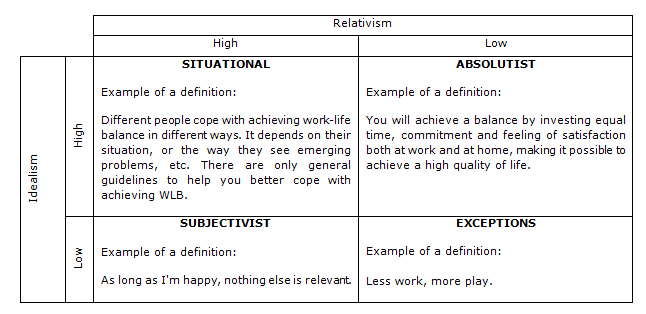Work-life balance (WLB) is a condition in which an individual copes with a potential conflict between different requirements of their time and energy in such a way, that it satisfies their desire for prosperity and fulfillment [Clutterbuck, 2005].
The interpretation of the phenomenon of work-life balance is possible thanks to identification of four vertebrae and the relations between them:
- the inner circle – space and time for me,
- the second circle – including space and time for beloved ones,
- the third circle – space and time for work.
- the outer circle – space and time for other people i.e. community.
The aforementioned areas have undoubtedly an impact on people's lives. Since, however, people put a very different emphasis on the various circles, the balance between investing time and energy in every single one of them is perceived subjectively, making it difficult and complicated to solve the difficulties arising in this area [Clutterbuck, 2005].
Given the moral dimension of WLB category one can use the taxonomy classifying this phenomenon with the use of two intersecting dimensions – idealism and relativism – to distinguish four types of definition of the work-life balance phenomenon: situational, absolutist, subjectivist and exceptions.
Table 1 shows examples of the definitions of each of the four types.
Table 1: Examples of the definition of work-life balance, taking into account the criterion of relativism and idealism.

Source: Own elaboration based on [Forsyth, 1980 in: Reiter, 2007].
Today, the presence of comprehensive actions in the field of work-life balance in organizations is an important challenge for them. Ways of tackling this ambitious intention are, among other, to include design and/or improve the system of compensation, taking into account the benefits from WLB and implement the concept of corporate social responsibility.
Measures aimed at maintaining the balance between work and personal life are one of the most elaborated components of the model of Total Rewards, developed by experts associated in the organization of the World at work. It includes 71 tools divided into categories [Sedlak, 2012]:
- flexibility of the working environment (flexible working hours, telecommuting, etc.),
- paid and unpaid leave,
- supporting activities related to health and well-being,
- supporting activities associated with taking care of family,
- financial support related to individual saving programmes,
- developing and promoting community involvement,
- encouraging shaping and modifying the organizational culture.
The above assumptions of the concept of work-life balance, and highlighting the role of businesses in shaping this state in their employees, are the most important reasons for conducting systematic research in the indicated area by the author of the Barometer. Carefully prepared and tailored to the environment through research work-life balance programmes can be a valuable proposition that takes into account what the organization can offer its employees, and also what they themselves need most.
- N. Reiter: Work Life Balance: What DO You Mean? The Ethical Ideology Underpinning Appropriate Application, The Journal of Applied Behavioral Science, Vol. 43/2007
- D. Clutterbuck: Równowaga między życiem zawodowym a osobistym. Przewodnik dla specjalistów do spraw personalnych. Wyd. Oficyna Ekonomiczna. Kraków 2005
- K. Sedlak: Total Rewards – przyszłość systemów wynagradzania. 2012, www.wynagrodzenia.pl, pobrano: 20.04.2014.

